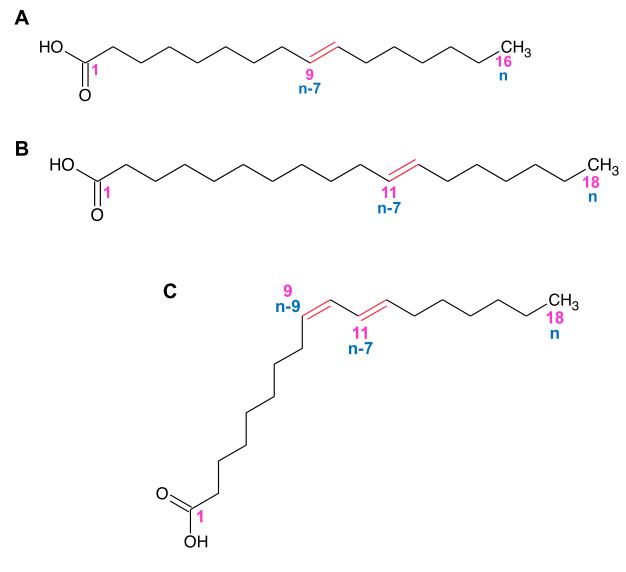The World Health Organization recommends that the daily intake of trans fatty acids (TFAs) does not exceed 1% of total energy intake. Lifeasible offers services to help detect TFAs in milk and milk products to aid in food health.
TFAs are unsaturated fatty acids and they are associated with cardiovascular disease, coronary heart disease, cancer, diabetes, and obesity. The industrial hydrogenation process produces TFAs. Human studies have found a positive correlation between cardiovascular disease development and industrial TFA intake. Some TFAs are produced during rumen fermentation in ruminants. The natural TFAs contained in ruminant milk (from cows, ewes, and goats) are mainly rumenic acid (cis-9, trans-11 C18:2, RMA), trans-vaccenic acid (trans-C18:1 n-7, TVA), and trans-palmitoleic acid (trans-C16:1 n-7, TPA) (Fig. 1). Although studies have found some beneficial effects of natural TFAs, excessive intake can still cause problems. One clinical trial reported that very high levels of vaccenic acid (i.e., 10 times than the usual consumed) had similar effects to industrial TFA on cardiovascular disease risk factors.
 Fig. 1 Structure of (A) trans-palmitoleic acid, (B) trans-vaccenic acid, and (C) rumenic acid (Guillocheau et al., 2019).
Fig. 1 Structure of (A) trans-palmitoleic acid, (B) trans-vaccenic acid, and (C) rumenic acid (Guillocheau et al., 2019).
Detection of TFAs by gas chromatography (GC)
The identification of TFAs is quite complex because these isomers are often interfered with by other fatty acid isomers (e.g., cis, iso, and anteiso) and therefore require preliminary separation or the use of specific chromatographic conditions. We offer a professional service where we help isolate and detect TFAs in milk and milk products concerning gas chromatography methods that comply with the International Organization for Standardization (ISO).
Operation flow:

Main reference standards:
ISO 16958:2015
ISO 14156:2001
ISO 15885:2002
Detection of TFAs by GC-mass spectrometry (MS)
The detection of TFAs easily interfered with other fatty acids. A GC-MS-based method can detect TFAs in milk and milk products more accurately and meet high throughput analysis. We also refer to the ISO standards to help isolate fatty acids and detect them with advanced instruments.
Detection of TFAs by Fourier transform infrared spectroscopy (FTIR)
Different functional groups absorb light at different wavelengths, so the absorption spectrum can be used to identify the types of fatty acids present in the sample. The C-H deformation vibration of the trans double bond induces a unique IR absorption band with maximum absorption at ca.966 cm-1 (10.3 m). Based on the intensity of this absorption band, TFAs can be measured. This method does not require converting the test sample to fatty acid methyl ester (FAME). It is simple and has high accuracy. We help detect TFAs in milk and milk products using FTIR spectroscopy to achieve simple and fast determination.
Operation flow:

Lifeasible offers professional services to help detect TFAs in milk and milk products. We mainly detect them by the GC method. We also use MS to assist high throughput detection and FTIR to rapidly detect TFAs. If customers need TFAs detection using other methods, we can also provide that. We are always oriented to customer needs and professional services. Please do not hesitate to contact us to discuss your milk testing project.
References
Lifeasible has established a one-stop service platform for plants. In addition to obtaining customized solutions for plant genetic engineering, customers can also conduct follow-up analysis and research on plants through our analysis platform. The analytical services we provide include but are not limited to the following:
STU-CRISPR System Improves Plant Genome Editing Efficiency
April 19, 2024
Application of Exosomes in Facial Beauty
April 12, 2024